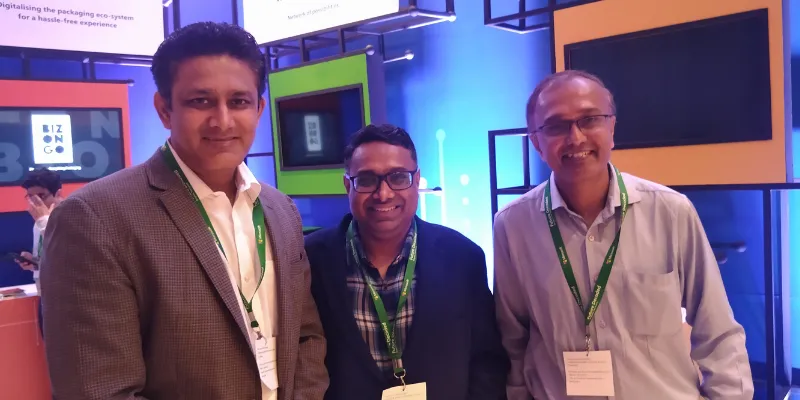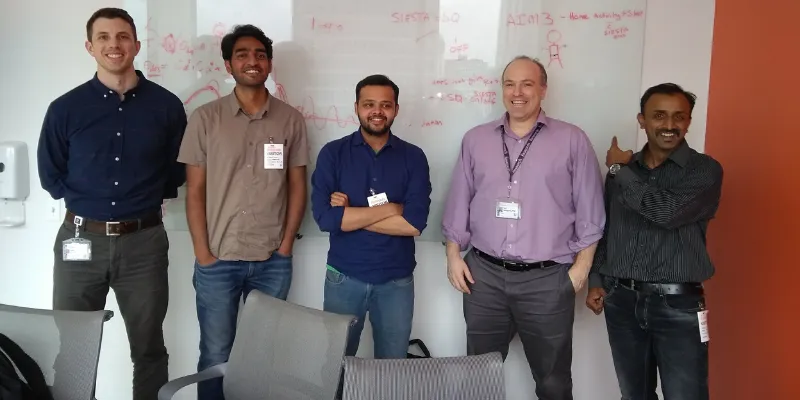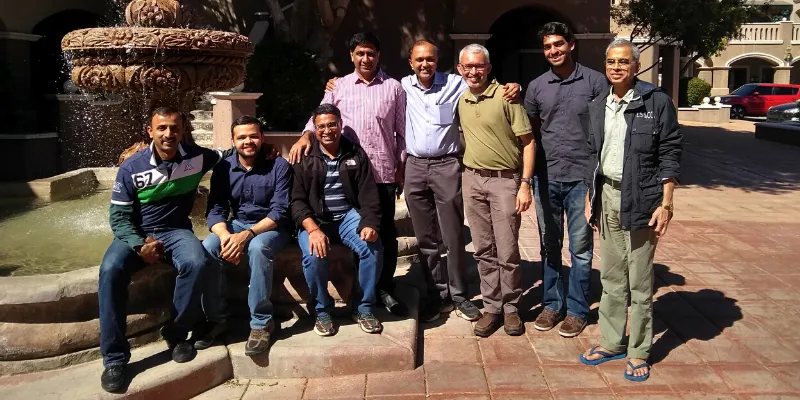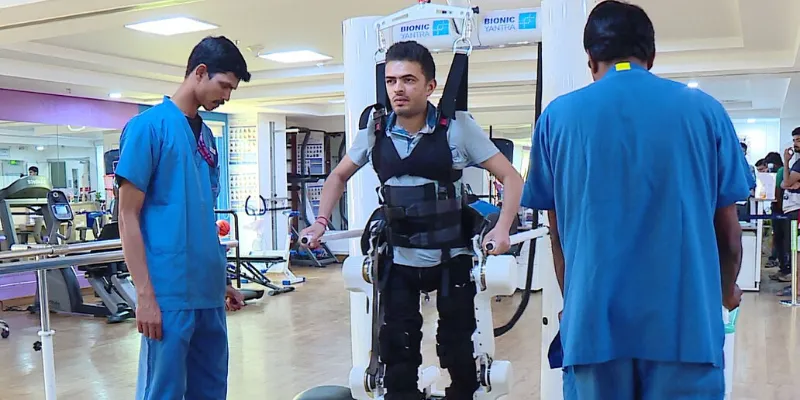This startup has developed a robotic exoskeleton to rehabilitate people who cannot walk
Founded by Vaidy Narayanan and Shiva Nagarajan, Bionic Yantra has built a Robotic Exoskeleton Assisted Rehabilitation System (REARS) that can accelerate the rehabilitation of individuals with spinal injuries and stroke.
According to a report published by the Rehabilitation Council of India, more than 15,000 people in India lose their ability to walk either due to a stroke or spinal injury. This translates to 15 new cases per million per year. For them, life changes for the worse. Even some of the most basic daily activities like walking, getting dressed, and travelling to work, becomes difficult. Recovery might take years, and many tend to lose their morale and confidence during this time.

Vaidy Narayanan and Shiva Nagarajan, Founders of Bionic Yantra with Anil Kumble.
To enable people to walk again, Vaidy Narayanan and Shiva Nagarajan founded in 2017. Along with their team, the duo developed a wearable robotic exoskeleton that assists those with spinal injuries move their limbs in controlled conditions, and thereby, advance their rehabilitation. It took a little more than two years for the startup to design, test and build the product.
The Bengaluru-based organisation aims to change the dynamics of the healthcare ecosystem with its Robotic Exoskeleton Assisted Rehabilitation Systems (REARS).
The genesis
When Vaidy’s cousin Sandeep was diagnosed with Transverse Myelitis in 2007, a type of spinal cord inflammation, his life came to a standstill.
“A lot of people tend to lose the ability to move around independently when they fall off trees, meet with an accident, or even get diagnosed with a particular illness. My cousin Sandeep V Manikrishnan was one of them,” says Vaidy Narayanan, Founder and Director, Bionic Yantra.
The 27-year-old was paralysed and unable to walk. To help his cousin, Vaidy got him a dismantlable wheelchair, which, in turn, brought about a huge transformation in Sandeep’s life. From being tied to apron strings, he became an earning member of his family by bagging a job at a bank.

The team of Timetooth Technologies.
A few years later, IIT-Madras, in collaboration with Phoenix Medical Systems, launched the country’s first prototype of an indigenously-designed standing wheelchair. Known as ‘Arise’, the device was capable of enabling people to independently move from a seated to an upright position and vice-versa. Vaidy was quite impressed by the innovation.
“I could see a lot of potential in the standing wheelchair. Around the same time, I also noticed exoskeletons being demonstrated on TV by a paralysed skier as part of the FIFA World Cup Inauguration. But I found out that the price of the exoskeleton was extremely high and beyond people’s budget,” he notes.
Vaidy did a bit of digging and found out about Dr Arun Jayaraman of the Rehabilitation Institute of Chicago (now called Shirley Ryan Ability Lab).
“Not only was Arun an expert in adaptive technologies to treat physical disablement, but had also researched in areas like prosthetics and rehabilitation robotics. So, I sent him the video of the standing wheelchair prototype and expressed my interest in talking to him. And, Dr Arun replied that he would be more than delighted to have a chat during his trip to India two months from then,” recollects Vaidy.

The team of Bionic Yantra.
Vaidy wanted to build a cost-effective exoskeleton to rehabilitate people with spinal injuries. So, he quit his job at the transportation vertical of ACS and began looking for a team of like-minded people to join his mission. First, Vaidy approached his friend Shiva Nagarajan, who was leading the IP solutions team at Capgemini. Later, he contacted his batchmate from college, Amitav Chaudhuri, the Director of Timetooth Technologies, a Noida-based engineering solutions company. Both Shiva and Amitav were happy to pitch in.
In 2016, the trio met Dr Arun, who agreed to offer his guidance. Vaidy, Shiva and Amitav spent a few months consulting many doctors and prosthetic specialists to gather their views and gain clarity on various metrics like market demand and expectations. They registered Bionic Yantra in January 2017 and together raised about Rs 5 lakh from their savings. A few days later, the incubator Social Alpha showed immense confidence in Bionic Yantra and invested a seed fund of Rs 50 lakh.
About this, Srikanth Prabhu, the Portfolio Lead of Social Alpha, said,
“Shiva and Vaidy were able to bring together an amazing set of collaborators with relevant expertise for quick product development. It was their passion and willingness to collaborate that made us invest in Bionic Yantra in its early days. More importantly, we saw Bionic Yantra as a force that could disrupt healthcare markets across the world and make rehabilitation a universal service accessible to all.”
How does the exoskeleton work?
Amitav started designing the robotic exoskeleton in 2017. Once it was complete and validated through three levels of tests, the team imported the components required to assemble the product from Germany and Switzerland.
“REARS was made using a complex set of control systems including the software as well as the hardware. A combination of motors, drives, AI and sensor technology was applied in the process. We obtained a great sense of gratification when we tested the device on people with various degrees of spinal cord injuries, and figured that it was working as expected,” quips Vaidy.

Prateek Khandelwal trying to walk with the help of Bionic Yantra's REARS.
REARS is mainly useful post a spinal surgery or a treatment session at the hospital. It aids them in rehabilitation by enabling the patient to stand, walk and move their limbs under medical supervision. The harness jacket provided as part of the device is first strapped after which the patient is lifted with the help of a powered winch. Next, the robotic exoskeleton is worn, after which the patient can move around and walk without any external support. In addition to this, the locomotive parameters and body vitals like joint movements, number of steps taken, heart rate, BP, etc, are recorded automatically by the device and sent to the cloud for the generation of medical reports.
“Patients, as well as doctors, can observe positive results after a series of sessions employing REARS. Not only is rehabilitation bolstered, but the chances of the person being able to walk in future increases. The entire system of REARS costs Rs 2 crore. Though this sounds like a whopping sum, most hospitals can monetise this within two years, assuming they charge around Rs 3,500 per session,” says Vaidy.
The Machine Intelligence and Robotics Center (MINRO) of IIIT Bengaluru recently purchased the exoskeleton from Bionic Yantra for further research. Tridib Roy, Senior Program Manager, MINRO said,
“The team of Bionic Yantra have done a phenomenal job in the development of the assistive robotic device. And, we have bought it mainly for the purpose of research. We are looking forward to working with the startup in creating well-defined data architecture for the product, make the harness more convenient by developing soft, body-hugging velcros and also set up certain personalised therapeutic protocols.”
Helping people to walk independently
Presently, Bionic Yantra is eyeing to sell its device mainly in the US, Europe and India. The team has already signed an MoU with The Rehabilitation Institute of Chicago. The Central Drug Standard Control Organisation (CDSCO) in India has approved its manufacture, and the team is in the process of getting permissions from the US FDA. NIMHANS and AIIMS have also tied up with Bionic Yantra to conduct more clinical research.
“There is definitely a lot of demand for our product in global markets. However, one of our biggest challenges has been about pooling in the capital for research and production. Not many venture capitalists are ready to put in the kind of money that is necessary to develop the device further and work on other versions of it. We hope to see a positive change in this sphere in the coming days,” adds Vaidy.
With REARS, Bionic Yantra is hoping to transform the lives of many patients who have lost hope of walking again. The team is also planning to build an affordable personal mobility device that people with injuries can use at home to regain their faculty to walk.
(Edited by Kanishk Singh)




1562078288155.png?fm=png&auto=format&h=100&w=100&crop=entropy&fit=crop)




